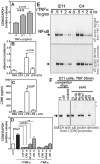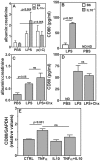TLR-mediated albuminuria needs TNFα-mediated cooperativity between TLRs present in hematopoietic tissues and CD80 present on non-hematopoietic tissues in mice
- PMID: 27125280
- PMCID: PMC4920147
- DOI: 10.1242/dmm.023440
TLR-mediated albuminuria needs TNFα-mediated cooperativity between TLRs present in hematopoietic tissues and CD80 present on non-hematopoietic tissues in mice
Abstract
Transient albuminuria induced by pathogen-associated molecular patterns (PAMPs) in mice through engagement of Toll-like receptors (TLRs) is widely studied as a partial model for some forms of human nephrotic syndrome (NS). In addition to TLRs, CD80 has been shown to be essential for PAMP-mediated albuminuria. However, the mechanistic relationships between TLRs, CD80 and albuminuria remain unclear. Here, we show that albuminuria and CD80-uria induced in mice by many TLR ligands are dependent on the expression of TLRs and their downstream signalling intermediate MyD88 exclusively in hematopoietic cells and, conversely, on CD80 expression exclusively in non-hematopoietic cells. TNFα is crucial for TLR-mediated albuminuria and CD80-uria, and induces CD80 expression in cultured renal podocytes. IL-10 from hematopoietic cells ameliorates TNFα production, albuminuria and CD80-uria but does not prevent TNFα-mediated induction of podocyte CD80 expression. Chitohexaose, a small molecule originally of parasite origin, mediates TLR4-dependent anti-inflammatory responses, and blocks TLR-mediated albuminuria and CD80-uria through IL-10. Thus, TNFα is a prominent mediator of renal CD80 induction and resultant albuminuria in this model, and small molecules modulating TLR-mediated inflammatory activation might have contributory or adjunct therapeutic potential in some contexts of NS development.
Keywords: CD80; IL-10; Proteinuria; TLR; TNFα.
© 2016. Published by The Company of Biologists Ltd.
Conflict of interest statement
The authors declare no competing or financial interests.
Figures







Similar articles
-
Interaction of CD80 with Neph1: a potential mechanism of podocyte injury.Clin Exp Nephrol. 2018 Jun;22(3):508-516. doi: 10.1007/s10157-017-1489-3. Epub 2017 Oct 11. Clin Exp Nephrol. 2018. PMID: 29022109
-
Toll-like receptor 3 ligands induce CD80 expression in human podocytes via an NF-κB-dependent pathway.Nephrol Dial Transplant. 2012 Jan;27(1):81-9. doi: 10.1093/ndt/gfr271. Epub 2011 May 26. Nephrol Dial Transplant. 2012. PMID: 21617192
-
Toll-like receptor 3 ligand, polyIC, induces proteinuria and glomerular CD80, and increases urinary CD80 in mice.Nephrol Dial Transplant. 2013 Jun;28(6):1439-46. doi: 10.1093/ndt/gfs543. Epub 2012 Dec 21. Nephrol Dial Transplant. 2013. PMID: 23262434 Free PMC article.
-
Insulin resistance and increased lipolysis in bone marrow derived adipocytes stimulated with agonists of Toll-like receptors.Horm Metab Res. 2010 Sep;42(10):703-9. doi: 10.1055/s-0030-1261872. Epub 2010 Jul 5. Horm Metab Res. 2010. PMID: 20603780
-
Outside influence: TLRs direct hematopoietic cell fates.Immunity. 2006 Jun;24(6):667-669. doi: 10.1016/j.immuni.2006.06.007. Immunity. 2006. PMID: 16782021 Review.
Cited by
-
Interaction of CD80 with Neph1: a potential mechanism of podocyte injury.Clin Exp Nephrol. 2018 Jun;22(3):508-516. doi: 10.1007/s10157-017-1489-3. Epub 2017 Oct 11. Clin Exp Nephrol. 2018. PMID: 29022109
-
The podocyte: glomerular sentinel at the crossroads of innate and adaptive immunity.Front Immunol. 2023 Jul 26;14:1201619. doi: 10.3389/fimmu.2023.1201619. eCollection 2023. Front Immunol. 2023. PMID: 37564655 Free PMC article. Review.
-
Urinary CD80 Discriminates Among Glomerular Disease Types and Reflects Disease Activity.Kidney Int Rep. 2020 Aug 14;5(11):2021-2031. doi: 10.1016/j.ekir.2020.08.001. eCollection 2020 Nov. Kidney Int Rep. 2020. PMID: 33163723 Free PMC article.
-
Dietary Effects of Fermented Cottonseed Meal Substituting Fishmeal on the Growth, Biochemical Indexes, Antioxidant Capacity, and Muscle Quality of Juvenile Golden Pompano (Trachinotus ovatus).Aquac Nutr. 2024 Jun 19;2024:9972395. doi: 10.1155/2024/9972395. eCollection 2024. Aquac Nutr. 2024. PMID: 39555570 Free PMC article.
-
Glomerular endothelial cells and podocytes can express CD80 in patients with minimal change disease during relapse.Pediatr Nephrol. 2020 Oct;35(10):1887-1896. doi: 10.1007/s00467-020-04541-3. Epub 2020 May 12. Pediatr Nephrol. 2020. PMID: 32399663 Free PMC article.
References
-
- Bagga A. and Mantan M. (2005). Nephrotic syndrome in children. Indian J. Med. Res. 122, 13-28. - PubMed
-
- Bakr A., Shokeir M., El-Chenawi F., El-Husseni F., Abdel-Rahman A. and El-Ashry R. (2003). Tumor necrosis factor-alpha production from mononuclear cells in nephrotic syndrome. Pediatr. Nephrol. Berl. Ger. 18, 516-520. - PubMed
Publication types
MeSH terms
Substances
Grants and funding
LinkOut - more resources
Full Text Sources
Other Literature Sources
Molecular Biology Databases
Miscellaneous

